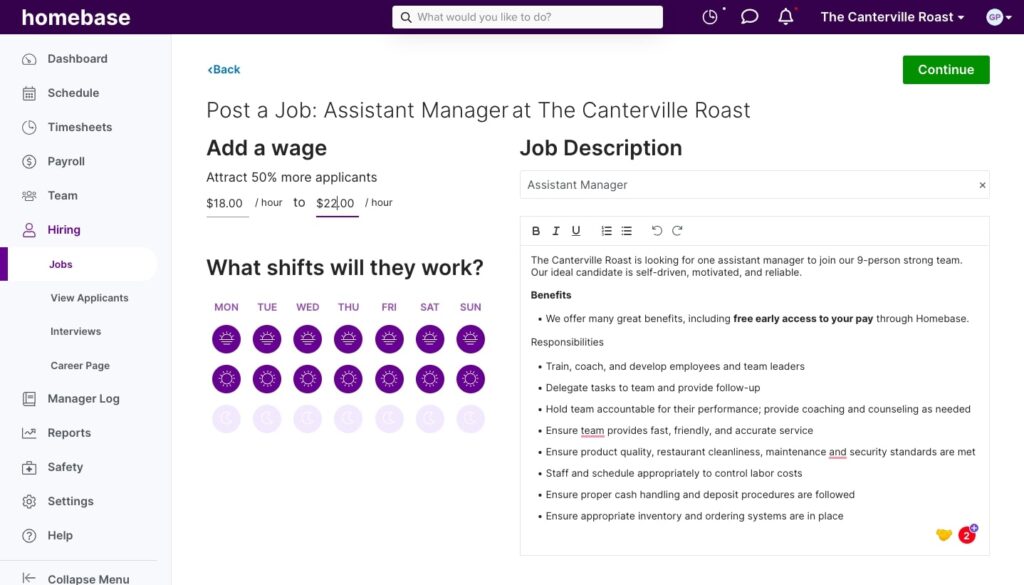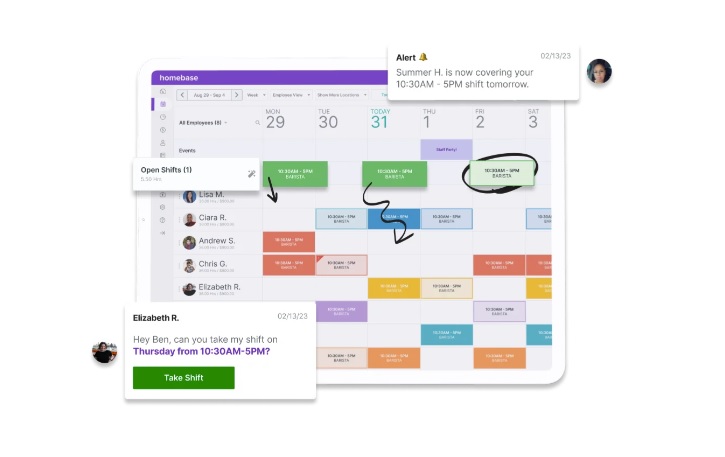
Every team member plays an important role in a small business — and people leaving can make a big impact. When valued employees leave, it can derail operations, leave customers dissatisfied, and impact staff morale, especially if you’re unable to replace them. Some forms of employee attrition can’t be helped: team members may retire or move to another city, or you may be forced to let staff go. But there’s a lot you can do to minimize staff quitting because they’re unhappy or demotivated, or having to fire people who aren’t a great fit.
That’s why we’ve put together this guide to preventing attrition in your small business. We’ll show you exactly how to keep morale high, make staff feel valued, and create an environment where employees want to stay, so you can retain your people and maintain your high standards.
Employee attrition explained
What is employee attrition?
Employee attrition usually refers to employees leaving positions that are not replaced, or not replaced immediately in the short term. This often means eliminating their role or merging it with other positions, reducing your overall headcount.
Attrition can be voluntary (when staff decide to leave) or involuntary (when you have to remove a role or lay people off).
That means employee attrition is a little bit different from turnover, which means all employees who leave the company, whether they’re replaced or not.
Why employee attrition matters
The costs of attrition add up quickly for small businesses. They include:
Lost productivity as positions remain vacant, meaning work gets neglected or dumped on others.
Decline in customer service — fewer employees may mean more mistakes, longer wait times, and more customer complaints and negative reviews.
Lower morale for the remaining team members who take on more workload
Loss of specialized knowledge held by departing employees, whether it’s in inventory management, restaurant logistics, or customer relatinships.
Time and money spent recruiting if roles are eventually refilled or new roles are created to compensate for the loss.
Losing several employees in a short timeframe can significantly impact operations and your bottom line. Consistently high attrition leads to a shrinking, understaffed business. Minimizing preventable attrition is a must,, especially for small businesses.
7 effective ways to reduce attrition
The good news is that there are many ways to beat attrition by understanding and improving your employees’ experience at your company.
Here are practical yet impactful tactics to invest in your team, retain your people, and keep your business thriving.
1. Measure attrition
The best place to start is understanding why and when attrition is happening. Being clear on what’s driving attrition will let you focus your retention efforts in the right place.
Here’s what to do:
Track the overall number and proportion of staff who leave (your attrition rate) and compare it with previous quarters and years to see if there’s a trend.
When staff leave, conduct an exit interview to ask about their reasons for leaving and see if a different way of doing things could have prevented it.
See whether there are patterns — are you constantly losing your floor managers, for example, or your late shift teams? Work out whether certain roles or teams are more likely to quit, and ask them why.
Review employee productivity analytics for early red flags. For example, Homebase lets you track frequent schedule changes and no-shows that often precede quits.
2. Attract the right people
It’s important to spend time upfront hiring people who have the right skills and work ethic — and genuinely fit with your culture and workflow.
Carefully screen applicants and set the right expectations by communicating your culture and what makes your business unique in the job post. Make sure you give a realistic sense of the work itself, including any challenges.
Then, at the interview stage, ask questions that go beyond learning about candidates’ past experiences to understand their attitudes and what motivates them.
Make sure you also check references thoroughly to verify performance and ethics — past behavior often predicts future behavior.

3. Foster positive relationships
Creating a sense of community keeps people invested in each other and your business, and workplace friendships are a strong anchor for employees.
That’s why you should:
Make time for regular in-person team activities, even simple things like sharing meals before opening time.
Model a supportive tone from the top-down. Make sure managers get to know everyone and take an interest in their lives.
Create opportunities for employees to socialize outside work, like group outings or virtual happy hours.
Recognize important events like birthdays, anniversaries and milestones.
Celebrate achievements together using Homebase shoutouts or praising people during team meetings.
4. Develop your employees
Investing in people’s growth shows them that you’re committed to their long-term future in your business.
Offer team members regular feedback and in your performance reviews, recognize their strengths and contributions as well as any areas of growth. Work with your employee to create a clear plan for improving on growth areas and taking on new assignments.
Give them the resources to improve, whether through mentoring and coaching, shadowing others, or completing a course. Support skill development through funded workshops or certifications.
It’s also a good idea to cross-train employees to build experience across roles.
Finally, create promotion pathways. Before recruiting outside the company, look to see if you can develop and promote your internal talent.
5. Prioritize work-life balance
Burnout from overwork is a major cause of attrition, especially if you have people working long shifts. You’ll retain more staff by making sure they have family and personal time.
Promote work-life balance by:
Limiting too much overtime. Use a tool like Homebase to track and predict overtime, and try to adapt schedules or balance overtime across your team.
Prioritizing employee happiness with perks like free snacks/drinks or early paycheck access.
Where possible, stay flexible with employee scheduling and accommodating appointments and family needs.
Scheduling enough recovery time between long shifts and overnight shifts. Look at using 2-2-3 or 2-3-2 work schedules that give shift workers regular blocks of time off.


6. Listen to your teams
Heard employees are happy employees. Make sure you take the time to listen to what your people have to say, so you can nip any issues in the bud and learn what they love about working for you.
Keep an open-door policy where people feel free to share concerns and suggestions with managers.
Actively seek feedback from your employees. Ask about problems and areas of dissatisfaction, and follow up with them to let them know you’ve heard their concerns and tell them how you’re addressing any issues. You may want to provide anonymous feedback forms or an anonymous feedback option in your team communication channel or app, so that people feel more comfortable being fully honest.
Make sure you also ask questions about what they appreciate — you’ll find out what they most value about your company culture, so you can keep doing it.
7. Prioritize communication
Great communication is the key to a happy, loyal team who’ll stick with you long term.
Here’s how you can build a strong communication culture and retain your people:
Make sure managers prioritize regular, informal checkins with their team to give people a chance to express themselves.
Involve your employees in big company goals and transitions. Be transparent about company performance, objectives, and initiatives, and ask for feedback before making a big change.
Use a clear communication method — or centralized employee app — for easy shift swaps and time-off requests.
Don’t only communicate with your staff when something’s wrong. Take the time to shout out achievements and celebrate when things are going well.
Use digital tools like Homebase’s team app to make sure people get important updates and can communicate within dedicated groups for particular shifts, teams, or projects.
How Homebase helps small businesses prevent employee attrition
As a small business owner, few problems are more painful than losing great people.
By following our seven key steps to engage, appreciate, and communicate with your team, you can minimize attrition and the loss of productivity and expertise that comes with it.
Of course, with limited hours in the day, it takes a lot of effort for small businesses to put the steps we’ve covered into practice. That’s where Homebase can help.
Homebase is an all-in-one HR and team management platform that helps small businesses retain their people.
Use our employee app for truly effective communications, from introducing new hires and sharing important information to group chats and checkins. You can even shout out employees to show their hard work is recognized.
Homebase scheduling tools help with work-life balance — a top reason people quit. As well as letting you create flexible schedules, features like shift swaps, time-off requests, and overtime tracking through our time clock help keep workloads reasonable.
Finally, Homebase helps you offer your employees perks they’ll value. Our cash out feature gives your team early access to their wages so they can cover unexpected expenses, at no cost to you.
Focusing on your people is one of the best investments you can make — and tools like Homebase help keep your top talent around for the long haul.







